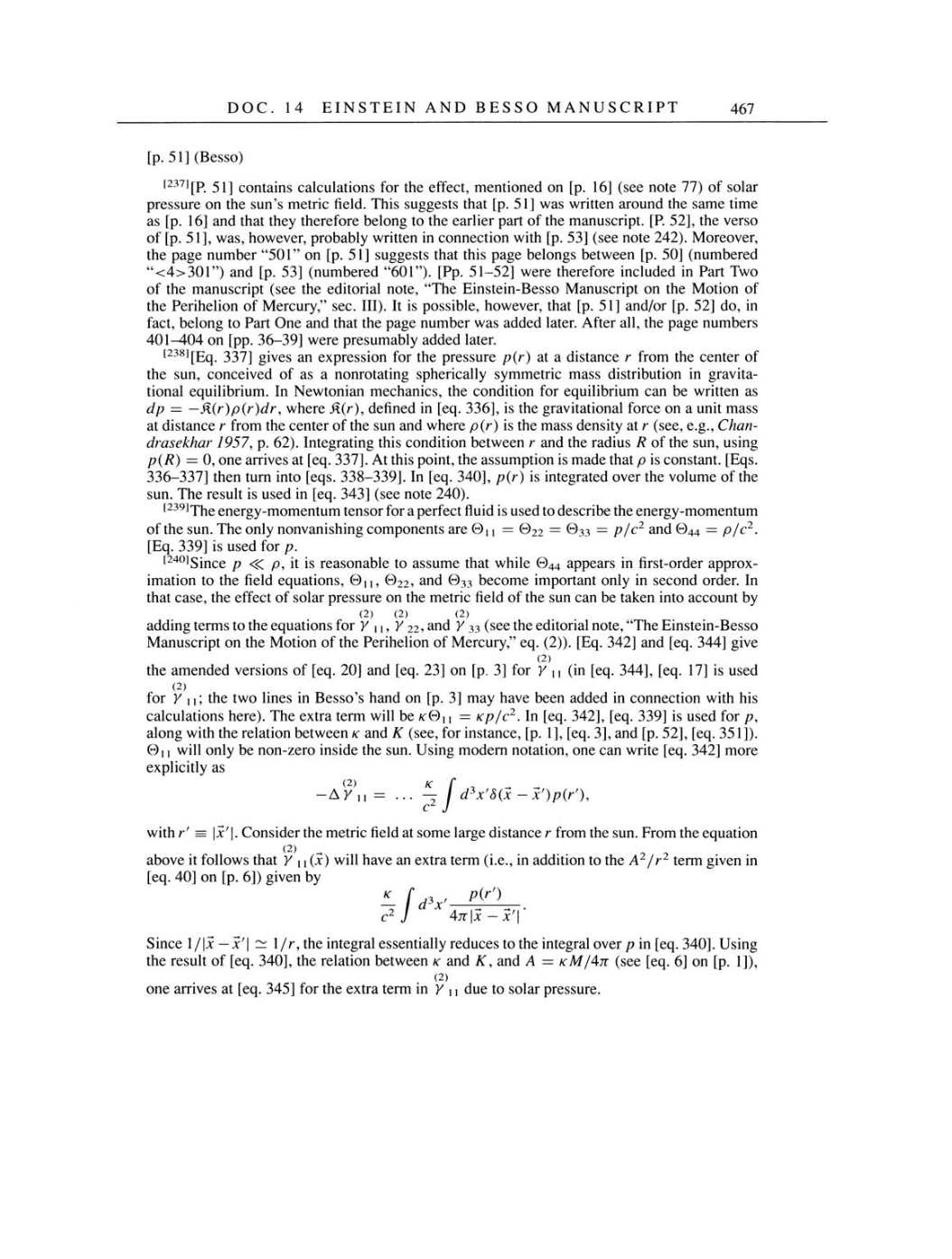DOC.
14 EINSTEIN AND
BESSO
MANUSCRIPT
467
[p.
51]
(Besso)
[237][P.
51]
contains
calculations for
the effect,
mentioned
on
[p. 16]
(see
note 77)
of solar
pressure
on
the sun's metric
field.
This
suggests
that
[p.
51]
was
written around the
same
time
as [p.
16]
and
that
they
therefore
belong
to
the earlier
part
of the
manuscript.
[P.
52],
the
verso
of
[p. 51],
was,
however,
probably
written
in
connection with
[p.
53]
(see note
242).
Moreover,
the
page
number "501"
on [p.
51] suggests
that
this
page belongs
between
[p.
50]
(numbered
"4301") and
[p. 53]
(numbered
"601").
[Pp.
51-52]
were
therefore included
in Part Two
of the
manuscript
(see
the editorial
note,
"The Einstein-Besso
Manuscript
on
the Motion of
the Perihelion of
Mercury,"
sec.
III).
It
is possible,
however,
that
[p.
51]
and/or
[p.
52]
do, in
fact,
belong
to
Part One and that the
page
number
was
added
later.
After
all,
the
page
numbers
401-404
on [pp.
36-39]
were
presumably
added
later.
[238][Eq.
337]
gives an
expression
for the
pressure
p(r)
at
a
distance
r
from the
center
of
the
sun,
conceived of
as a nonrotating spherically symmetric
mass
distribution
in
gravita-
tional
equilibrium.
In
Newtonian
mechanics,
the condition for
equilibrium
can
be
written
as
dp
=
-&(r)p(r)dr, where
£(r),
defined
in
[eq.
336], is the
gravitational
force
on a
unit
mass
at
distance
r
from the
center
of
the
sun
and
where
p(r)
is
the
mass
density
at
r
(see, e.g.,
Chan-
drasekhar
1957,
p. 62).
Integrating
this
condition between
r
and the
radius
R
of the
sun, using
p(R)
=
0,
one
arrives
at
[eq.
337]. At this
point,
the
assumption
is
made that
p is constant.
[Eqs.
336-337]
then
turn
into
[eqs.
338-339].
In
[eq.
340],
p(r)
is integrated
over
the volume of the
sun.
The result
is
used
in
[eq. 343]
(see note
240).
[239]The energy-momentum
tensor for
a
perfect
fluid
is
used
to
describe the
energy-momentum
of
the
sun.
The
only nonvanishing components
are
011
=
022
=
033
=
p/c2
and 044
=
p/c2.
[Eq.
339]
is
used for
p.
[240]Since
p
£
p, it is
reasonable
to
assume
that while
044
appears
in
first-order
approx-
imation
to
the
field
equations,
011, 022, and
©33
become
important only
in
second
order. In
that
case,
the effect of solar
pressure
on
the
metric
field
of
the
sun can
be
taken
into
account
by
(2) (2) (2)
adding
terms
to
the
equations
for y
11,
y
22,
and y
33
(see
the editorial
note,
"The Einstein-Besso
Manuscript
on
the Motion of
the
Perihelion of
Mercury,"
eq.
(2)).
[Eq.
342]
and
[eq.
344]
give
(2)
the amended versions of
[eq. 20]
and
[eq. 23]
on
[p. 3]
for
y
11
(in [eq.
344],
[eq.
17]
is
used
(2)
for y
11;
the two
lines in
Besso's hand
on [p. 3]
may
have been
added in connection
with his
calculations
here).
The
extra term will be k011
=
Kp/c2.
In
[eq.
342],
[eq. 339]
is
used for
p,
along
with
the
relation between
k
and
K (see,
for
instance,
[p. 1], [eq.
3],
and
[p.
52],
[eq.
351]).
©11
will
only
be
non-zero
inside
the
sun.
Using
modern
notation,
one can
write
[eq. 342]
more
explicitly
as
(2)
K
f
-2
-
A y
u =
...
-
I d3x'8(x
-
x')p(r'),
with r'
= /x'/.
Consider
the metric
field
at
some
large
distance
r
from
the
sun.
From
the
equation
(2)
above it follows
that
Y
11
(x)
will
have
an
extra term (i.e.,
in addition
to
the
A2/r2
term
given
in
[eq. 40]
on
[p.
6])
given by
^
c
Jf
4n\x
-
x
\
Since
1/\x
-
x'\
-
1/r, the
integral essentially
reduces
to
the
integral over p
in
[eq.
340]. Using
the result of
[eq.
340],
the relation between
k
and K, and
A
=
kM/4n (see
[eq.
6]
on [p. 1]),
(2)
one
arrives
at
[eq.
345]
for the
extra term
in
y
11
due
to
solar
pressure.
